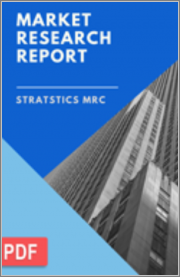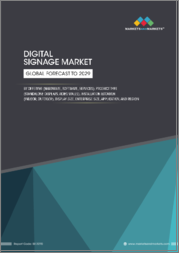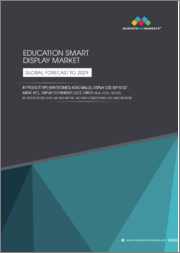
|
시장보고서
상품코드
1324229
세계의 LED 비디오 월 시장 예측(-2030년) : 제품 유형별, 유형별, 컴포넌트별, 레이아웃별, 위치별, 디스플레이 기술별, 최종 사용자별, 지역별 분석Light Emitting Diode Video Walls Market Forecasts to 2030 - Global Analysis By Product Type, Type, Component, Layout, Location, Display Technology, End User and By Geography |
||||||
세계의 LED 비디오 월(Light Emitting Diode Video Walls) 시장은 2023년 291억 8,000만 달러에서, 예측 기간 동안 CAGR 12.9%로 추이하여 2030년에는 682억 3,000만 달러에 이를 것으로 예측됩니다.
LED 기술을 이용한 대형 디스플레이 솔루션의 생산, 판매 및 설치는 LED 비디오 월산업의 주요 주력 분야입니다. LED 비디오 벽으로 알려진 고해상도 디스플레이는 다수의 LED 패널로 구성되어 서로 보이지 않도록 연결되어 놀라운 시각 효과를 만듭니다. LED 패널은 크기와 모양의 자유도가 높기 때문에 특정 설치 요구에 맞게 독특한 비디오 벽 구성을 만들 수 있습니다. 이러한 비디오 월은 소매점, 스포츠 경기장, 제어실, 엔터테인먼트 시설 등 다양한 산업에서도 사용되고 있습니다.
대만의 ITIS(산업기술정보서비스)에 따르면, 대만은 현재 30개 이상의 LED 제조업체들에서 세계 수요의 약 절반을 생산하고 있습니다.
모든 산업에서 도입 확대
음악 콘서트, 스포츠 이벤트, 정치 집회, 제품 발표회 등의 프로모션 활동과 제어실, 박물관, 전시회 등에서 중요한 정보를 표시하기 위해 에너지 효율적인 디스플레이 시스템의 사용이 확대되고 있음 하지만 성장의 주요 요인입니다. 또한 양방향 인터랙티브 비디오 월의 광범위한 기술 혁신은 병원에서 환자 경험과 소매점에서 쇼핑 경험을 모두 향상시키고 LED 비디오 월산업에 새로운 기회를 제공합니다. 강당, 쇼핑몰 등에서 다양한 품목에 대한 정보를 표시해야 할 필요성 또한 예상 기간 동안 LED 비디오월에 대한 수요를 증가시킬 것입니다.
투자비용 상승
LED 비디오 월의 높은 설치 비용으로 인해 재정적 불확실성이 발생할 수 있습니다. LED 비디오월 디스플레이의 투자 비용은 다른 형태의 디지털 사이니지에 비해 높습니다. 기업은 LED 비디오월 프로젝트를 위한 자금을 따로 마련해야 합니다. 예를 들어, 165인치 벽면은 하이엔드 스크린의 경우 6만 달러에서 8만 달러 사이입니다. 이러한 요소는 LED 비디오월의 시장 확대를 저해할 가능성이 높습니다.
기술 진보
LED 비디오 월 시장은 소비자 요구의 변화에 따라 LED 비디오 월의 기술 개발이 진행됨에 따라 확대되고 있습니다. 또한 인공지능, 머신러닝, 빅데이터 애널리틱스 등 첨단기술 발전로 LED 비디오 월의 도입이 증가하고 시장의 성장을 가져오고 있습니다.
온도와 수명이 조명 품질에 영향을 미칠 수 있음
노화로 인해 발생하는 LED 색상 변화는 품질에 영향을 미칠 수 있습니다. 온도가 LED에 영향을 미칠 수 있는 것과 마찬가지로, 추운 기후에서 LED 비디오월을 사용하면 성능에 영향을 미칠 수 있습니다. 또한 LED 벽은 더 얇아지는 경우가 많기 때문에 깨지기 쉽고 파손되기 쉽습니다. 결과적으로 다른 비디오 월 옵션에 비해 휴대성이 떨어질 수 있습니다. 이러한 한계는 예측 기간 동안 시장을 방해 할 수 있습니다.
COVID-19의 영향 :
COVID-19 발발로 인해 부정적인 영향을 받았습니다. 비디오월은 재택근무로 전환한 다양한 비즈니스에서 온라인 비디오, Zoom 통화 및 기타 매체를 통한 방송의 창의적인 배경으로 사용되고 있습니다. 전례 없는 봉쇄 조치로 인해 LED 비디오월은 엔터테인먼트 및 접객업 분야에서 수요 감소를 경험하고 있습니다.
예측 기간 동안 운송 부문이 최대가 될 전망
예측 기간 동안 운송 부문은 가장 큰 점유율로 시장을 지배 할 것으로 예상됩니다. 운송 산업에서 가장 널리 사용되는 디지털 기술은 공항, 기차역, 버스 터미널과 같은 주요 교통 허브에서 볼 수 있는 LED 비디오 월입니다. 이러한 소비자 행동의 변화로 인해 이제 기업은 모든 교통 수단에서 타겟 고객의 마음속에 브랜드를 전략적으로 구축할 수 있게 되었습니다. 이는 예상 기간 동안 LED 비디오월 시장을 견인할 것으로 예상됩니다.
다이렉트 뷰 LED 비디오 월부문이 예측 기간 동안 가장 높은 CAGR이 예상됨
다이렉트 뷰 LED 비디오 월 부문은 예측 기간 동안 크게 성장할 것으로 예상됩니다. 대형 디스플레이는 일반적으로 실외 디스플레이에 사용되는 이러한 비디오 월을 구성합니다. 주로 실외 디스플레이에 사용되지만 이제는 트렌드 변화로 인해 실내 디스플레이를위한 더 나은 픽셀 솔루션이기도합니다. 또한 다이렉트 뷰 비디오월은 최고 밝기 수준, 가변 픽셀 옵션, 베젤이 거의 없어 매끄러운 경험을 제공한다는 장점이 있습니다.
가장 점유율이 높은 지역
LED 비디오 월의 세계 동향은 아시아 태평양이 독점하고 있으며, 이러한 추세는 예측 기간 동안 지속될 것으로 예상됩니다. 한국, 중국, 일본, 인도를 포함한 국가 소매업체는 더 많은 고객을 유치하고 시장에서 경쟁하기 위해 디지털 정보와 최첨단 광고를 제시하기 위해 LED 비디오 월을 점점 더 활용하고 있습니다. 스마트 리테일의 확대, VR과 AR을 이용한 인터랙티브 디스플레이 유닛의 출현, 이 지역의 옥외 스포츠와 오락 이벤트 증가 등이 이 지역 시장 성장에 기여하고 있습니다.
CAGR이 가장 높은 지역 :
예측 기간 동안 북미는 시장에서 가장 높은 CAGR을 기록할 것으로 예상됩니다. 최근 몇 년동안 기업은 최첨단 기술을 활용하여 비디오 월을 통해 고객과 교류하고 있습니다. 미술관, 점포, 경기장, 교통기관 등 공공 장소에도 설치되어 있습니다. 앞으로 몇 년동안 이러한 요인이 이 지역의 LED 비디오 월 수요를 촉진할 것으로 예상됩니다.
무료 사용자 지정 옵션 :
이 보고서를 구독하는 고객에게는 다음 무료 사용자 정의 옵션 중 하나를 제공합니다.
- 기업 개요
- 추가 시장 기업의 종합적 프로파일링(3사까지)
- 주요 기업의 SWOT 분석(3사까지)
- 지역 세분화
- 고객 관심에 따른 주요 국가 시장 추정 및 예측·CAGR(주 : 타당성 확인에 따라 다름)
- 경쟁 벤치마킹
- 제품 포트폴리오, 지리적 입지, 전략적 제휴에 기반한 주요 기업 벤치마킹
목차
제1장 주요 요약
제2장 서문
- 개요
- 이해관계자
- 조사 범위
- 조사 방법
- 데이터 마이닝
- 데이터 분석
- 데이터 검증
- 조사 접근
- 조사 소스
- 1차 조사 소스
- 2차 조사 소스
- 가정
제3장 시장 동향 분석
- 성장 촉진 요인
- 억제 요인
- 기회
- 위협
- 제품 분석
- 용도 분석
- COVID-19의 영향
제4장 Porter's Five Forces 분석
- 공급기업의 협상력
- 구매자의 협상력
- 대체품의 위협
- 신규 참가업체의 위협
- 경쟁 기업간 경쟁 관계
제5장 세계의 LED 비디오 월 시장 : 제품 유형별
- 매립형 LED 디스플레이
- 슬랫형 LED 디스플레이
제6장 세계의 LED 비디오 월 시장 : 유형별
- 혼합 프로젝션 비디오 월시스템
- 다이렉트 뷰 LED 비디오 월
- 실내용 LED 비디오 월
제7장 세계의 LED 비디오 월 시장 : 컴포넌트별
- 하드웨어
- 소프트웨어
- 서비스
- 설치
- 유지보수
- 렌탈
제8장 세계의 LED 비디오 월 시장 : 레이아웃별
- 표준
- 커스텀
제9장 세계의 LED 비디오 월 시장 : 위치별
- 실내
- 옥외
제10장 세계의 LED 비디오 월 시장 : 디스플레이 기술별
- 2D 디스플레이
- 3D 디스플레이
제11장 세계의 LED 비디오 월 시장 : 최종 사용자별
- 은행 및 금융 서비스·보험(BFSI)
- 교육
- 호텔 및 레스토랑
- 미디어·광고
- 소매
- 스포츠·엔터테인먼트
- 운송
- 공항
- 철도
- 버스 터미널
- 기타 최종 사용자
제12장 세계의 LED 비디오 월 시장 : 지역별
- 북미
- 미국
- 캐나다
- 멕시코
- 유럽
- 독일
- 영국
- 이탈리아
- 프랑스
- 스페인
- 기타 유럽
- 아시아 태평양
- 일본
- 중국
- 인도
- 호주
- 뉴질랜드
- 한국
- 기타 아시아 태평양
- 남미
- 아르헨티나
- 브라질
- 칠레
- 기타 남미
- 중동 및 아프리카
- 사우디아라비아
- 아랍에미리트(UAE)
- 카타르
- 남아프리카
- 기타 중동 및 아프리카
제13장 주요 발전
- 계약/파트너십/협업/합작투자(JV)
- 인수와 합병
- 신제품 발매
- 사업 확대
- 기타 주요 전략
제14장 기업 개요
- Barco
- Cetech
- Christie Digital Systems USA Inc.
- Delphi Display Systems
- Delta Electronics Inc.
- Leyard Optoelectronic Co., Ltd.
- LG Electronics
- Lighthouse Technologies Limited.
- Panasonic Corporation
- Primeview Global
- Planar
- Samsung Electronics
- Sharp NEC Display Solutions
- Sony Corporation
- Toshiba Corporation
- ViewSonic Corporation
According to Stratistics MRC, the Global Light Emitting Diode (LED) Video Walls Market is accounted for $29.18 billion in 2023 and is expected to reach $68.23 billion by 2030 growing at a CAGR of 12.9% during the forecast period. The production, sale, and installation of large-scale display solutions utilizing Light-Emitting Diode (LED) technology are the primary areas of focus for the LED video wall industry. High-resolution displays known as LED video walls are made up of numerous LED panels that are connected invisibly to one another to produce a stunning visual effect. Due to the size and shape flexibility of LED panels, unique video wall configurations can be made to meet particular installation needs. These video walls are also used in a variety of industries, such as retail, sports arenas, control rooms, and entertainment venues.
According to the ITIS (Industrial Technology Information Service) of Taiwan, Taiwan now produces around half the world's demand from its more than 30 LED manufacturers.
Market Dynamics:
Driver:
Growing adoption in all industries
The growth is primarily driven by the expanding use of energy-efficient display systems for promotional activities at an increasing number of music concerts, sporting events, political rallies, and product launches, as well as the requirement to display critical information in control rooms, museums, and exhibitions. Additionally, the extensive innovation of bi-directional interactive video walls improves both the patient experience in hospitals and the shopping experience in retail stores, opening up new opportunities for the LED video wall industry. The need to display information about various items in auditoriums, shopping malls, etc. will also increase demand for LED video walls during the anticipated period.
Restraint:
Higher investment costs
Financial uncertainties may result from higher installation costs for LED video walls. The investment cost of LED video wall displays is high when compared to that of other forms of digital signage. Businesses must set aside money for their LED video wall project. For instance, a 165-inch wall can run between $60,000 and $80,000 for high-end screens. Such factors are likely to impede the market expansion for LED video walls.
Opportunity:
Technological advancements
The LED video walls market is expanding as a result of ongoing technological developments in LED video walls brought on by shifting consumer demands. Dubbed planar direct light ultra-series and fine pitch LED video walls, these are two recent innovations that are influencing the market. Furthermore, the adoption of LED video walls has increased as a result of advancements in cutting-edge technologies like artificial intelligence, machine learning, and big data analytics, which have resulted in the growth of the market.
Threat:
Temperature & age can impact light quality
The LED color shift that occurs with aging could have an effect on quality. Similar to how temperature can affect LEDs, using an LED video wall in colder climates may affect performance. LED walls are also frequently thinner, which makes them more brittle and susceptible to breaking. They might be less portable as a result compared to other video wall options. Such limations may hinder the market in the forecast period.
COVID-19 Impact:
Due to a significant slowdown in manufacturing activities, China, which is the primary manufacturing hub for electronic goods, has been negatively impacted by the COVID-19 outbreak. Video walls are being used as a creative backdrop for broadcasts through online videos, Zoom calls, and other mediums by a variety of businesses that have shifted to remote operations from homes. Due to the unprecedented lockdown that was imposed, LED video walls are experiencing a drop in demand in the entertainment and hospitality sectors.
The transportation segment is expected to be the largest during the forecast period
Over the course of the forecast period, the transportation segment is anticipated to dominate the market with the largest share. The most prevalent digital technology used in the transportation industry is the LED video wall, which is found in major transportation hubs like airports, train stations, and bus terminals. Because of this shift in consumer behavior, businesses are now able to strategically establish their brands in the minds of their target audiences across all transportation modes. This is anticipated to drive the market for LED video walls during the anticipated period.
The direct-view LED video walls segment is expected to have the highest CAGR during the forecast period
The direct-view LED video walls segment is expected to grow significantly in the forecast period. Large displays make up these video walls, which are typically used for outdoor displays. Although they are primarily used for outdoor displays, they are now also better pixel solutions for indoor displays due to changing trends. Additionally, direct-view video walls have the advantage of offering the highest brightness levels, variable pixel options, and almost no bezels, creating a seamless experience.
Region with largest share:
Global sales of LED video walls were dominated by the Asia-Pacific region, and this trend is anticipated to continue during the forecast period. Retailers from nations including South Korea, China, Japan, and India are increasingly utilizing LED video walls to present digital information and cutting-edge advertisements to draw in more customers and compete in the market. The expansion of smart retail, the emergence of interactive display units using VR and AR, and an increase in outdoor sporting and entertainment events in the region have all contributed to the market growth in the area.
Region with highest CAGR:
During the forecast period, North America is expected to register the highest CAGR in the market. In recent days, businesses have been using cutting-edge techniques to interact with their clients via video walls. They are putting them in public places like museums, shops, stadiums, and transportation systems. In the upcoming years, these factors are anticipated to fuel demand for LED video walls in this region.
Key players in the market:
Some of the key players profiled in the Light Emitting Diode (LED) Video Walls Market include: Barco, Cetech, Christie Digital Systems USA Inc., Delphi Display Systems, Delta Electronics Inc., Leyard Optoelectronic Co., Ltd., LG Electronics, Lighthouse Technologies Limited., Panasonic Corporation, Primeview Global, Samsung Electronics, Sharp NEC Display Solutions, Sony Corporation, Toshiba Corporation and ViewSonic Corporation.
Key Developments:
In June 2023, Samsung Electronics announced its new digital signage lineup at InfoComm 2023, North America's largest audiovisual trade show, taking place in Orlando, Florida from June 14 to 16. The Wall for Virtual Production's LED display features pixel pitch options of P1.68 and P2.1, dedicated studio frame rates (23.976, 29.97 and 59.94Hz) and genlocking, which can synchronize the screen with a camera's video signal. The display also boasts a refresh rate of up to 12,288Hz, a max brightness of 1,500nits, a 35,000:1 fixed contrast ratio (for P2.1) and up to 170-degree wide viewing angles. All these new features combine to enable an unprecedented level of picture quality for virtual content.
In October 2022, Planar, a global leader in visualization technology, announced a new addition to the company's portfolio of outdoor fine pitch LED display solutions with the release of a fine pitch, high bright outdoor LED video wall designed for up close viewing. The Planar® Luminate™ Ultra Series LED video wall display features coated LEDs to deliver ruggedness and exceptional image detail for high-ambient light.
Product Types Covered:
- Embedded LED display
- Slatted LED display
Types Covered:
- Blended Projection Video Wall System
- Direct view LED video walls
- Indoor LED video walls
Components Covered:
- Hardware
- Software
- Service
Layouts Covered:
- Standard
- Custom
Locations Covered:
- Indoor
- Outdoor
Display Technologies Covered:
- 2-D Display
- 3-D Display
End Users Covered:
- Banking, Financial Services and Insurance (BFSI)
- Educational Institutes
- Hotel and Restaurants
- Media & Advertising
- Retail
- Sports & Entertainment
- Transportation
- Other End Users
Regions Covered:
- North America
- US
- Canada
- Mexico
- Europe
- Germany
- UK
- Italy
- France
- Spain
- Rest of Europe
- Asia Pacific
- Japan
- China
- India
- Australia
- New Zealand
- South Korea
- Rest of Asia Pacific
- South America
- Argentina
- Brazil
- Chile
- Rest of South America
- Middle East & Africa
- Saudi Arabia
- UAE
- Qatar
- South Africa
- Rest of Middle East & Africa
What our report offers:
- Market share assessments for the regional and country-level segments
- Strategic recommendations for the new entrants
- Covers Market data for the years 2021, 2022, 2023, 2026 and 2030
- Market Trends (Drivers, Constraints, Opportunities, Threats, Challenges, Investment Opportunities, and recommendations)
- Strategic recommendations in key business segments based on the market estimations
- Competitive landscaping mapping the key common trends
- Company profiling with detailed strategies, financials, and recent developments
- Supply chain trends mapping the latest technological advancements
Free Customization Offerings:
All the customers of this report will be entitled to receive one of the following free customization options:
- Company Profiling
- Comprehensive profiling of additional market players (up to 3)
- SWOT Analysis of key players (up to 3)
- Regional Segmentation
- Market estimations, Forecasts and CAGR of any prominent country as per the client's interest (Note: Depends on feasibility check)
- Competitive Benchmarking
- Benchmarking of key players based on product portfolio, geographical presence, and strategic alliances
Table of Contents
1 Executive Summary
2 Preface
- 2.1 Abstract
- 2.2 Stake Holders
- 2.3 Research Scope
- 2.4 Research Methodology
- 2.4.1 Data Mining
- 2.4.2 Data Analysis
- 2.4.3 Data Validation
- 2.4.4 Research Approach
- 2.5 Research Sources
- 2.5.1 Primary Research Sources
- 2.5.2 Secondary Research Sources
- 2.5.3 Assumptions
3 Market Trend Analysis
- 3.1 Introduction
- 3.2 Drivers
- 3.3 Restraints
- 3.4 Opportunities
- 3.5 Threats
- 3.6 Product Analysis
- 3.7 Application Analysis
- 3.8 Impact of Covid-19
4 Porters Five Force Analysis
- 4.1 Bargaining power of suppliers
- 4.2 Bargaining power of buyers
- 4.3 Threat of substitutes
- 4.4 Threat of new entrants
- 4.5 Competitive rivalry
5 Global Light Emitting Diode (LED) Video Walls Market, By Product Type
- 5.1 Introduction
- 5.2 Embedded LED display
- 5.3 Slatted LED display
6 Global Light Emitting Diode (LED) Video Walls Market, By Type
- 6.1 Introduction
- 6.2 Blended Projection Video Wall System
- 6.3 Direct view LED video walls
- 6.4 Indoor LED video walls
7 Global Light Emitting Diode (LED) Video Walls Market, By Component
- 7.1 Introduction
- 7.2 Hardware
- 7.3 Software
- 7.4 Service
- 7.4.1 Installation
- 7.4.2 Maintenance
- 7.4.3 Rental
8 Global Light Emitting Diode (LED) Video Walls Market, By Layout
- 8.1 Introduction
- 8.2 Standard
- 8.3 Custom
9 Global Light Emitting Diode (LED) Video Walls Market, By Location
- 9.1 Introduction
- 9.2 Indoor
- 9.3 Outdoor
10 Global Light Emitting Diode (LED) Video Walls Market, By Display Technology
- 10.1 Introduction
- 10.2 2-D Display
- 10.3 3-D Display
11 Global Light Emitting Diode (LED) Video Walls Market, By End User
- 11.1 Introduction
- 11.2 Banking, Financial Services and Insurance (BFSI)
- 11.3 Educational Institutes
- 11.4 Hotel and Restaurants
- 11.5 Media & Advertising
- 11.6 Retail
- 11.7 Sports & Entertainment
- 11.8 Transportation
- 11.8.1 Airports
- 11.8.2 Railways
- 11.8.3 Bus Terminals
- 11.9 Other End Users
12 Global Light Emitting Diode (LED) Video Walls Market, By Geography
- 12.1 Introduction
- 12.2 North America
- 12.2.1 US
- 12.2.2 Canada
- 12.2.3 Mexico
- 12.3 Europe
- 12.3.1 Germany
- 12.3.2 UK
- 12.3.3 Italy
- 12.3.4 France
- 12.3.5 Spain
- 12.3.6 Rest of Europe
- 12.4 Asia Pacific
- 12.4.1 Japan
- 12.4.2 China
- 12.4.3 India
- 12.4.4 Australia
- 12.4.5 New Zealand
- 12.4.6 South Korea
- 12.4.7 Rest of Asia Pacific
- 12.5 South America
- 12.5.1 Argentina
- 12.5.2 Brazil
- 12.5.3 Chile
- 12.5.4 Rest of South America
- 12.6 Middle East & Africa
- 12.6.1 Saudi Arabia
- 12.6.2 UAE
- 12.6.3 Qatar
- 12.6.4 South Africa
- 12.6.5 Rest of Middle East & Africa
13 Key Developments
- 13.1 Agreements, Partnerships, Collaborations and Joint Ventures
- 13.2 Acquisitions & Mergers
- 13.3 New Product Launch
- 13.4 Expansions
- 13.5 Other Key Strategies
14 Company Profiling
- 14.1 Barco
- 14.2 Cetech
- 14.3 Christie Digital Systems USA Inc.
- 14.4 Delphi Display Systems
- 14.5 Delta Electronics Inc.
- 14.6 Leyard Optoelectronic Co., Ltd.
- 14.7 LG Electronics
- 14.8 Lighthouse Technologies Limited.
- 14.9 Panasonic Corporation
- 14.10 Primeview Global
- 14.11 Planar
- 14.12 Samsung Electronics
- 14.13 Sharp NEC Display Solutions
- 14.14 Sony Corporation
- 14.15 Toshiba Corporation
- 14.16 ViewSonic Corporation



















